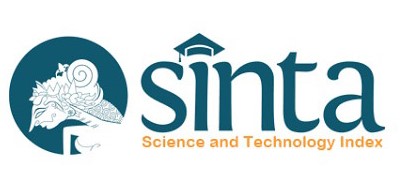Epidural Anesthesia Management in Cesarean Section with Placenta Accreta
Abstract
Background: In pregnant women, the spectrum of placenta accreta is considered a high risk syndrome. Placenta accreta is responsible for 7-10% of all maternal deaths worldwide. This study reports on a patient with placenta accreta who underwent a cesarean section using epidural anesthesia.
Case: A 30-year-old woman (Gravida: 3, Abortus: 1, Partus: 1) with a gestational age of 8 months came to the hospital. with 8 months of gestation was diagnosed with antepartum hemorrhage et causa placenta previa totalis morbidly adherent placenta high risk with planned elective cesarean section with bilateral tubectomy to hysterectomy, Double J (DJ) stent, Ballooning using epidural anesthesia with physical American Society of Anesthesiologists (ASA) II status. Local anesthetic with 2% lidocaine 2 ml, 12 ml of 0.5% bupivacaine given in incremental doses of 4 ml every 5 minutes while monitoring the patient's hemodynamics. Intraoperative drugs consist of intravenous (IV) dexamethasone 5 mg IV, ondansetron 8 mg IV, tranexamic acid 1 gram, paracetamol 1 gram IV, bupivacaine 0.5% 3ml every 1 hour via an epidural catheter. Maintenance using O2 3 lpm. The operation lasted 450 minutes, with stable outcome both maternal and fetal.
Conclusion: Anesthesia management in patients with bleeding during labor is very important. In this case, epidural anesthesia provide a good outcome in maternal and fetal after cesarean section in placenta accreta patient.
Keywords
Full Text:
PDFReferences
Bailit JL, Grobman WA, Rice MM, et al. Morbidly adherent placenta treatments and outcomes. Obstet Gynecol. 2015;125(3):683-689. doi:10.1097/AOG.0000000000000680
Chantraine F, Langhoff-Roos J. Abnormally invasive placenta--AIP. Awareness and pro-active management is necessary. Acta Obstet Gynecol Scand. 2013;92(4):369-371. doi:10.1111/aogs.12130
Shamshirsaz AA, Fox KA, Salmanian B, et al. Maternal morbidity in patients with morbidly adherent placenta treated with and without a standardized multidisciplinary approach. Am J Obstet Gynecol. 2015;212(2):218.e1-9. doi:10.1016/j.ajog.2014.08.019
Shamshirsaz AA, Fox KA, Erfani H, et al. Multidisciplinary team learning in the management of the morbidly adherent placenta: outcome improvements over time. Am J Obstet Gynecol. 2017;216(6):612.e1-612.e5. doi:10.1016/j.ajog.2017.02.016
Tarantino F, Calì G. Placenta Accreta: Management by Peridural Anesthesia. Clin Manag Issues. 2021;15(1):1-7. doi:10.7175/cmi.v15i1.1500
Lilker SJ, Meyer RA, Downey KN, Macarthur AJ. Anesthetic Considerations for Placenta Accreta. Obstet Anesth Dig. 2012;32(4):229. doi:10.1097/01.aoa.0000422709.12146.bc
Snegovskikh D, Clebone A, Norwitz E. Anesthetic management of patients with placenta accreta and resuscitation strategies for associated massive hemorrhage. Curr Opin Anaesthesiol. 2011;24(3):274-281. doi:10.1097/ACO.0b013e328345d8b7
Muñoz LA, Mendoza GJ, Gomez M, Reyes LE, Arevalo JJ. Anesthetic management of placenta accreta in a low-resource setting: a case series. Int J Obstet Anesth. 2015;24(4):329-334. doi:10.1016/j.ijoa.2015.05.005
Purwoko P, Rusman R, Aditya MR. Serial Kasus: Manajemen Anestesi pada Wanita Hamil dengan Plasenta Akreta yang Direncanakan Tindakan Seksio Sesarea. J Anestesi Obstet Indones. 2020;3(1):26-34. doi:10.47507/obstetri.v3i1.40
Li P, Liu X, Li X, Wei X, Liao J. Clinical outcomes and anesthetic management of pregnancies with placenta previa and suspicion for placenta accreta undergoing intraoperative abdominal aortic balloon occlusion during cesarean section. BMC Anesthesiol. 2020;20(1):133. doi:10.1186/s12871-020-01040-8
Toledano RD, Leffert LR. Anesthetic and Obstetric Management of Placenta Accreta: Clinical Experience and Available Evidence. Curr Anesthesiol Rep. 2017;7(1):93-102. doi:10.1007/s40140-017-0200-2
Rugeri L, Levrat A, David JS, et al. Diagnosis of early coagulation abnormalities in trauma patients by rotation thrombelastography. J Thromb Haemost. 2007;5(2):289-295. doi:10.1111/j.1538-7836.2007.02319.x
DOI: http://dx.doi.org/10.21776/ub.jap.2022.003.03.05
Refbacks
- There are currently no refbacks.

This work is licensed under a Creative Commons Attribution 4.0 International License.









.png)

